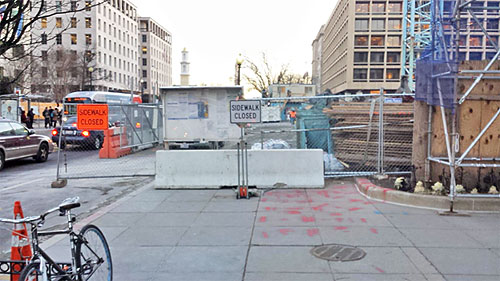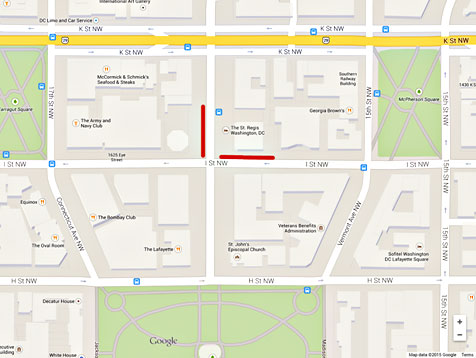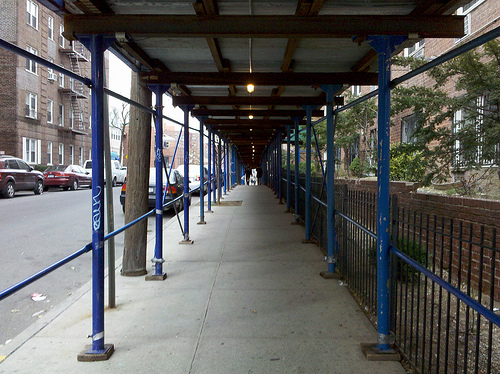Walkblock of the week #1: 16th and I
In a booming city, construction is part of life. But when construction closes sidewalks it makes walking more difficult and dangerous. The District Department of Transportation (DDOT) has a policy requiring that construction closures keep a safe path open for pedestrians and cyclists, but that often doesn’t happen in reality.

Is this a “safe and convenient accomodation”? All photos by the author.
This new series, in collaboration with pedestrian advocacy group All Walks DC, will examine one sidewalk closure each week. I’ll look at why the sidewalk is closed and how it fits with the city’s policies on paper.
Is there a blocked sidewalk near you? Email the location and photos to allwalksdc@gmail.com or tweet with the hashtag #dcwalkblock.
Location #1: The former Third Church at 16th and I
Our first location is on the west side of 16th Street NW, north of I Street. This is the site that formerly held the Third Church of Christ, Scientist, a Brutalist building that stirred up a major historic preservation fight when the church asked to demolish it. The building is gone, and a new building will rise in its place.
Meanwhile, the sidewalk is closed in the heart of downtown, two blocks from the White House, in an area with many people walking on the street.

The red line on the left shows the closed sidewalk on 16th St NW. Base map from Google Maps.
DDOT granted permission
I checked the online permits, and it appears that the construction company got the permits and signage from DDOT necessary to close the sidewalk.
Even though DDOT granted permission, this might not comply with the agency’s own policies. The policy on closures, which dates to 2007 and was updated in 2014 to include bicycles, requires construction sites to maintain “a safe and convenient route for pedestrians… that is equal to the accommodation that was provided… before the blockage of the sidewalk.” Despite this policy, we continue to find sidewalks closed throughout the city, making walking inconvenient, putting people on foot in serious danger, and eroding the city’s image as a world-class multimodal city.
At the 16th Street site, I have routinely seen people walking in the roadway, adjacent to moving traffic. George Branyan, DDOT’s Pedestrian Program Coordinator, said that sidewalk was closed because the building was being demolished. According to Branyan,
The developer expressed the need to keep the sidewalk and parking lane closed on 16th Street for unloading and deliveries. At the time, we did not see placing pedestrians in the roadway a viable option, and we considered it safest to direct pedestrians to the opposite sidewalk.
While we agree that pedestrian safety is paramount, the prevalence of pedestrians walking in the street shows that the sidewalk closure is neither safe, convenient, or even well-respected. It clearly fails to meet DDOT’s own policy to maintain safe and convenient access.
Both lanes of car traffic on 16th Street, however, remain open as usual; the burden of construction falls exclusively on those on foot and not at all on those in cars.

People in cars move as normal, while those on foot take a detour.
What does the future hold?
After the building’s construction is complete, the church and developer plan to rebuild the sidewalk, expand the tree boxes, and plant a double row of trees where now there is just a single row. This was part of the project’s zoning approval.
For this streetscape work, the sidewalk will again close, but this time there will be a barricade to let pedestrians walk in the lane next to the curb. According to Branyan, “With such heavy pedestrian traffic in this location, it was appropriate to maintain pedestrian access.”
This solution provides a reasonable accommodation that is both safe and convenient. One just wonders why this wasn’t part of the current construction phase as well. DDOT’s policy is good; its leaders just need to take it seriously all the time and be consistent in enforcing it.

A New York sidewalk scaffold. Some DC construction projects also build these, but many don’t. Photo by Matt Green on Flickr.
Where the policy works: New York
DC is a great place to walk, but sidewalk closures make walking less safe and send a clear message to people walking that they are not a priority in DC. New York City, on the other hand, has made a clear and visible policy to keep sidewalks open during all stages of construction, including demolition. That sends an explicit message that walking is a top priority there. Let’s learn from another world class city, and make DC an even better place to walk.
